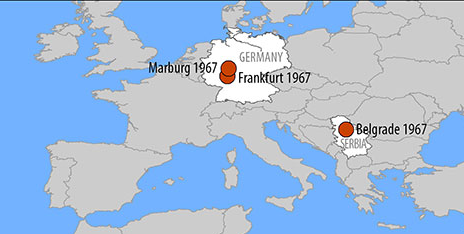Global Study Reveals Over 9% of Land Faces High Risk of Zoonotic Diseases

A recent study has highlighted a pressing global health concern, revealing that more than 9% of the world’s land area is classified as having a high or very high risk of zoonotic outbreaks, which occur when infections are transmitted between animals and humans. This alarming statistic is particularly relevant in light of the COVID-19 pandemic and other zoonotic diseases such as Ebola and SARS, which are prioritized by the World Health Organization (WHO) due to their potential to cause widespread epidemics.
The findings from the study, published in the journal *Science Advances*, indicate that approximately 3% of the global population resides in these extremely high-risk areas, while nearly 20% live in regions categorized as medium-risk. The research team, which included scientists from the European Commission’s Joint Research Centre (JRC) in Italy, utilized data from the Global Infectious Diseases and Epidemiology Network and the WHO to assess the spatial distribution of zoonotic threats.
According to Dr. Maria Rossi, a lead researcher at the JRC, "Our analysis reveals that 9.3% of the global land surface is at high (6.3%) or very high (3%) risk of zoonotic disease outbreaks. This underscores the urgent need for enhanced monitoring and public health strategies to mitigate these risks."
The study also finds a concerning link between climate change and the increased risk of zoonotic diseases. Factors such as rising temperatures, altered rainfall patterns, and water scarcity are driving conditions that elevate the likelihood of spillover events, where diseases jump from animals to humans. This correlation is supported by the work of Dr. James Thompson, an environmental scientist at the University of California, who states, "Climate-related environmental changes are reshaping the habitats of many species and, consequently, the dynamics of disease transmission."
Geographically, the study indicates that regions such as Latin America (27%) and Oceania (18.6%) face significant risks, along with 7% of Asia and 5% of Africa experiencing high and very high risks of zoonotic outbreaks. This data raises critical questions about global health preparedness and response strategies. According to Dr. Eliza Martin, a public health expert at Johns Hopkins University, "The identification of high-risk areas is vital for policymakers to allocate resources effectively and enhance epidemic preparedness."
The implications of these findings are profound. The study advocates for the integration of climate adaptation and mitigation into public health planning, emphasizing that proactive measures must be taken to safeguard populations against potential outbreaks. As highlighted by the authors, “Translating these risk estimates into an epidemic risk index allows for the identification of high-risk areas and supports policymakers in improving response capacities.”
Supporting this perspective, a study conducted by the Indian Council of Medical Research (ICMR) found that over 8% of infectious disease outbreaks reported between 2018 and 2023 in India were zoonotic in nature. This statistic emphasizes the urgency of addressing zoonotic threats as a global health priority. The ICMR study, published in *The Lancet Regional Southeast Asia* in May 2023, analyzed nearly 7,000 outbreaks, confirming that zoonotic infections are a consistent concern.
In conclusion, the intersection of environmental change and public health poses a formidable challenge. As our planet continues to face the impacts of climate change, the need for multidisciplinary approaches that include epidemiological research, environmental science, and public health policy becomes increasingly clear. Future strategies must prioritize international collaboration and resource allocation to effectively combat the threats posed by zoonotic diseases, ensuring a safer future for global populations.
Advertisement
Tags
Advertisement





